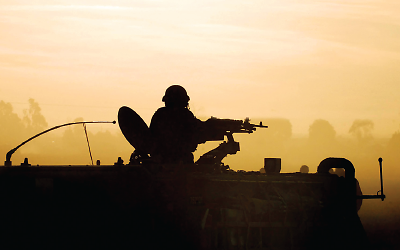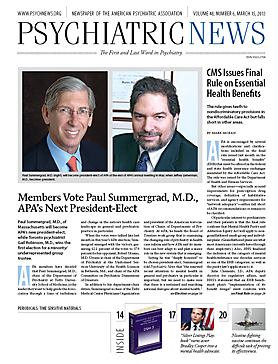Risk Factors for PTSD in Combat Soldiers Identified
A group of researchers based at Tel Aviv University in Israel, the University of Maryland, and the National Institute of Mental Health recently set out to define risk and resilience factors associated with development of posttraumatic stress disorder (PTSD) in combat soldiers that could be targeted by novel therapeutic treatments. They conducted a longitudinal prospective study of more than 1,000 Israeli Defense Force infantry soldiers (mean age 18.8 years) from 2008 to 2010. Repeated measurements during a one-year period included baseline and predeployment data collected in training camps and deployment data collected in the combat theater.
They found that soldiers developed threat vigilance during combat deployment, particularly when they were exposed to high-intensity combat, as indicated by faster response times to targets appearing at the location of threat relative to neutral stimuli. Threat-related attention bias also interacted with combat exposure to predict risk for PTSD. Bias toward threat at recruitment and bias away from threat just before deployment predicted postcombat PTSD symptoms. Moreover, these threat-related attention associations with PTSD were moderated by genetic and environmental factors, including serotonin transporter (5-HTTLPR) genotype.
The data “show plasticity in attentional components of threat processing in soldiers trained and deployed to combat duties,” concluded the researchers. “These changes in threat processing interact with combat exposure and genetic variability in the serotonin transporter gene to predict risk for PTSD symptoms.”
The work was supported by the Leo and Julia Forchheimer Foundation in collaboration with Mount Sinai School of Medicine and by the Intramural Research Program of the National Institute of Mental Health.
Domestic Violence, Maternal Depression Have Early Effects on Kids
Researchers at Indiana University School of Medicine recently evaluated the effects of intimate-partner violence (IPV) and maternal depression on a population of children who have not been well-studied: those who have not yet reached school age. IPV is defined by the Centers for Disease Control and Prevention as “a pattern of coercive behaviors that may include repeated battering and injury, psychological abuse, sexual assault, progressive social isolation, deprivation, and intimidation.” Previous studies of IPV have focused on school-age children and children in high-risk samples.
In this prospective study, researchers looked at more than 2,400 children receiving care from clinics that implemented the Child Health Improvement Through Computer Automation (CHICA) system. They linked parental IPV and depression with subsequent billing and pharmacy data during the November 1, 2004, to June 7, 2012, period. They found that 5.2 percent of parents reported IPV and 31.5 percent reported depressive symptoms at least once during routine pediatric visits within the first three years of a child’s life; 2.4 percent of the sample reported both. Exposure to both IPV and depression before age 3 was associated with preschool-aged onset of attention-deficit/hyperactivity disorder (ADHD), and early exposure to parental depression was associated with being prescribed psychotropic medications.
“Pediatricians play a critical role in performing active, ongoing surveillance of families with these known social risk factors and providing early intervention to negate long-term sequelae,” concluded the researchers.
Diagnostic Criteria for Misophonia Presented
Researchers at the University of Amsterdam have presented a description of and criteria for diagnosis of a new and discrete psychiatric disorder they have termed misophonia. The condition is a preoccupation with a specific aversive human sound that triggers impulsive aggression.
The researchers recruited through a hospital Web site 42 patients who reported misophonia. All patients were interviewed by an experienced psychiatrist and screened with a version of the Yale-Brown Obsessive-Compulsive Scale, which the researchers named the Amsterdam Misophonia Scale (A-MISO-S). On a six-item scale (range 0–24) patients were asked about the (1) time they spent on misophonia; (2) interference with social functioning; (3) level of anger; (4) resistance against the impulse; (5) control they had over their thoughts and anger; and (6) time they spent avoiding misophonic situations.
“We found in all patients a similar pattern of intense anger when hearing certain human sounds, impulsive reactions, avoidance of cue-related situations, worry of losing control, and the occurrence of obsessive-compulsive personality traits,” they said, noting that the symptoms they described cannot be classified in the current DSM-IV TR or ICD-10 systems.
Depression May Diminish Response to Shingles Vaccine
Individuals with untreated depression may have a higher risk of developing shingles, developing more severe cases of shingles, and being less responsive to the shingles vaccine than nondepressed individuals, said researchers at the Cousins Center for Psychoneuroimmunology at the UCLA Semel Institute for Neuroscience. Their study, part of the Shingles Prevention Study (SPS), was designed to evaluate the association between major depression and immune responses to a high-titer live attenuated varicella zoster virus (VZV) vaccine (zoster vaccine), which boosts cell-mediated immunity (CMI) to VZV and decreases incidence and severity of herpes zoster (HZ). The depression substudy was a two-year longitudinal cohort study of 92 community-dwelling adults aged 60 and over.
The researchers found that depressed patients have diminished VZV-CMI responses to zoster vaccine, and treatment with antidepressant medication was associated with normalization of these responses. “Because higher levels of VZV-CMI correlate with lower risk and severity of HZ, untreated depression may increase the risk and severity of HZ and reduce the efficacy of zoster vaccine,” they concluded. ■

